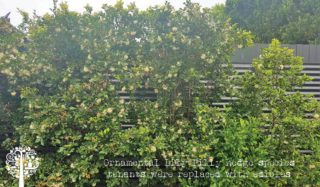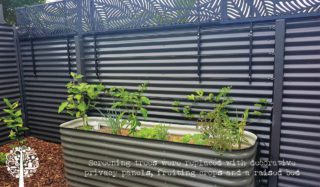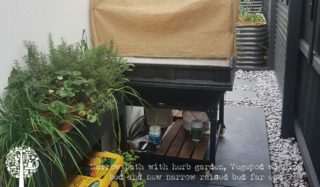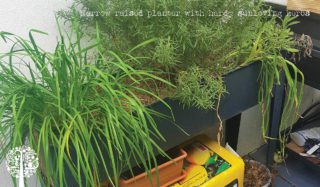Urban food gardeners are often challenged by confined spaces with limited options for growing edibles. Many people have to juggle the functionality of outdoor spaces. It can be tricky to balance outdoor seating, lawn for pets and children to play, privacy screens from neighbors, and structural elements like the clothesline and bins. So how do you squeeze food into already tight areas?
Many of my clients have small properties and experience these limitations but are still keen to grow food, especially in uncertain times. Food security has become a higher priority for many homeowners and beginner gardeners. However, in urban suburbs and densely populated estates, most properties have narrow access down the sides of the home. These areas often lack privacy and are underutilized or overshadowed by neighboring buildings. Limited sunlight and wind tunnels are common issues. Boundary fences are usually very close to the house eaves with very little room for planting.
Understandably, many homeowners choose low-maintenance ornamental plants for landscaping. However, some ornamental shrubs and trees can take up valuable space without providing tangible benefits regarding food, privacy, or habitat. So how can we overcome these common challenges and find room for edibles?
Small Space Design
Good design and careful plant choices can open up opportunities for many gardeners. Let’s take a look at some examples. Amy and Lachlan are a busy young couple with two dogs and a new baby. Their backyard consists of a tiny lawn, paved outdoor entertaining area, and hedging plants to provide privacy between their very close neighbors.
Their goal is to grow at least some fruit, vegetables, and herbs. However, the only way they could make room for some edible species was to be tough ‘landlords.’ Some of their ornamental plant ‘tenants’ were taking up valuable real estate. The attractive hedge species did provide privacy, but they needed regular pruning. They were in a prime position for sunlight during winter and morning sun/afternoon shade in summer. This ideal food garden position was wasted by ‘leasing’ out this zone to existing non-edibles. They removed three large trees with thoughtful re-design and had room to use the space wisely while not sacrificing their privacy—a highly productive decision.
Instead of a living hedge screen, decorative panels were added to the fence, keeping the neighbors happy. With the trees gone, there was room in the corner for a dwarf lemon tree (the fruit they buy and use most often). This new compact VIP plant tenant will provide a return on investment for years to come, as citrus trees fruit year-round in our subtropical climate. With thick mulch at the base, the lemon tree doesn’t compete with the lawn for nutrients.
Growing Up
The next element in their design was to choose a narrow raised garden bed positioned snugly beside the fence. This is suitable for a variety of perennial and annual vegetables. Steel wires were attached to posts to fully utilize the fence space behind the raised bed, ideal for edible climbers. Since passionfruit have a long life and growing season, one was planted on either side of the raised bed. The vines are being trained upwards to take advantage of vertical growing space. The fruit will be easy to harvest, and the vines will soften the fence as a living green wall. They are also thinking of extending the vertical growing system along the next section of the fence to expand the available vertical growing space.
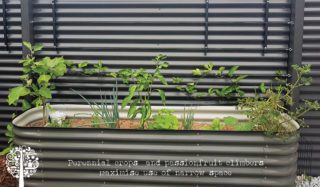
Reusing ‘Waste’
The raised garden bed is quite deep. So, it would have been costly and pointless to fill the entire depth with soil. By utilizing the Hugelkultur technique – a way of layering organic ‘waste’ from natural materials, Amy and Lachlan could save the time and effort of removing the trees off-site. The trunks, branches, and dead leaves that were cut down from the trees were laid at the bottom of the raised bed and layered with lawn clippings up to about 30cm (12”). Over time, this organic matter will decompose and create healthy, moisture-holding soil with native worms, mycorrhizal fungi, and beneficial microbes. This technique adds value by reusing natural materials onsite and sequestering carbon into the soil.
The rest of the bed was layered and filled with compost, aged cow manure, rehydrated coir peat, rock minerals, and slow-release organic pelletized nutrients. After topping with mulch, they planted new perennial plants like compact mini Lebanese eggplant, banana capsicum, and ginger, along with strawberries, celery, spinach, and spring onions.
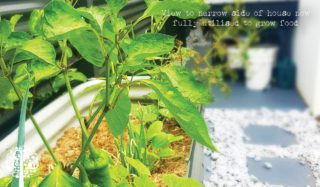
Careful plant choices with space-saving varieties and thoughtful positioning allow the entire garden bed to be fully utilized without compromising a harvest. In just a few weeks, the plants are already producing fruiting crops, and the passionfruit have taken advantage of the sunlight to start climbing the wires.
Meals on Wheels and Insitu Planter
Along the narrow pathway to the clothesline was a dead zone where an old leaking water tank was removed. Pavers were added, and another portable garden was installed. The Vegepod is a raised garden bed on wheels providing around 1m2 of growing space under a lid. This solution is ideal for filtering strong sunlight, protecting from pests and curious pet dogs who would otherwise dig up dinner! This raised bed is used for leafy greens and herbs; quick picks close to the kitchen.
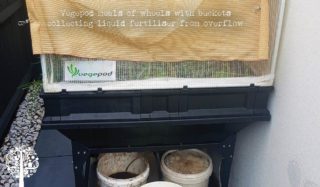
Another narrow planter sits up tight against the wall under the eaves. This area doesn’t benefit from rainfall and is hand-watered, but most herbs are hardy species like sage, garlic chives, thyme, and rosemary. They have similar water and full sun needs, so they are perfect pot partners.
Free Fertilizers
The Vegepod water reservoir pumps out nutrient-rich liquid fertilizer captured in buckets and watering cans and reused on the other edibles. No wasted nutrients!
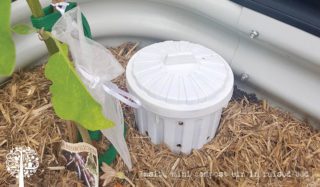
Likewise, a mini insitu compost bin has been installed in the raised bed. Kitchen scraps and green garden waste is added to the bin. Holes have been drilled below the lid, down the sides, and in the base to encourage worms and beneficial microbes to enter and decompose the food rather than it ending up in a landfill. Worms fertilize the plants with their nutrient-rich vermicast manure, reducing the need to fertilize. By adding rock minerals to the mini compost bin, the worms also redistribute these in a bioavailable form for the plants to take up quickly.
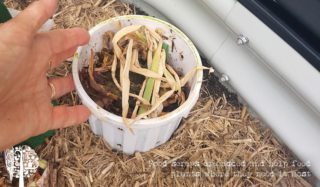
The holes below the lid are left open above the mulch so black soldier flies can enter to lay their eggs. Their larvae are fast decomposers and recycle the food scraps into a liquid fertilizer that leaches out of the base. This system is ideal for busy gardeners. No heavy turning of compost systems is required. Instead, they employ nature’s free ‘workers’ to do the hard composting work for them, a win-win solution for putting more food on the table sooner.
